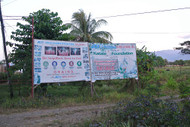Katala - Protecting the Red Vent Cockatoo - PART 1
Posted by Katala, Parrot conservation on 26/1/2024
Dot Schwarz explains more about her visits to Katala
Non-Parrot people criticise me for caring as much about Parrots as I care about people. Let me explain. The traditional Christian point of view states that God set man dominion over all the animals.
Humans
But instead of seeing humans as the apex of creation, we can see ourselves as part of the natural world, albeit the most destructive part. We can believe that every creature on the planet has value in itself.
I’d like to live in a society where cruelty to animals is considered as blameworthy as cruelty to human beings. And many of us who think and feel this way support animal rights, animal welfare and conservation.
I’ve read about projects and interviewed individuals involved with bird conservation but I’d never visited a project in the field so I was thrilled when my dear friend Chris Shank from Oregon USA, a Cockatoo owner and trainer and ex-breeder for over thirty years, invited me to accompany her to visit the Katala Foundation in the Philippines.
Nest sites
Next day is even more exciting. We’re taken to two nest sites on another island to bring down some chicks for ringing and examination.
We set off in two pump boats, Chris and I, Indira, René the chief research officer on Pandanan, several wardens.

The village capitana comes along for the ride. As headman of the village (last year it was her husband) she takes an enormous interest in the Cockatoos and their survival.
Without her support and that of the village council she chairs, Katala’s work would be impossible. The atmosphere’s hilarious, everyone in the two pump boats joking and laughing.
Barangay Pandanan, the island on which the nest trees are situated, belongs to a wealthy, private individual who runs a pearl fishery there. In consequence, he agrees to preserve forest cover. This is so valuable for Cockatoo breeding. We’re met by four wardens; one is an ex- poacher, now the only tree climber in that group.
Forest
The walk is the toughest so far through lowland forest on a track that sometimes dwindles, but Indira and Rene, the research officer, know exactly which fork to take. Rene kindly provides me with a stout stick.
We halt in a small clearing in front of a majestic Pometia tree 30 – 50 m high - a favoured nest tree. When Katala began, they wanted the ex-poachers to use modern safety harness to reach the nests but the climbers, who are all ex-poachers, rejected that outright after one attempt. Now all climbing is done the traditional way. Scary for onlookers like me.
Thirty-five year old Sabino has been with Katala since the inception. He used to be a poacher and now he’s a warden. The girth of the nest tree is too wide to be climbed so he shimmies up a slender tree next to it.

To read about the rest of Dorothy Schwarz's visit to the Katala Foundation, click here.
For more information on conservation issues relating to Parrots please click here.

